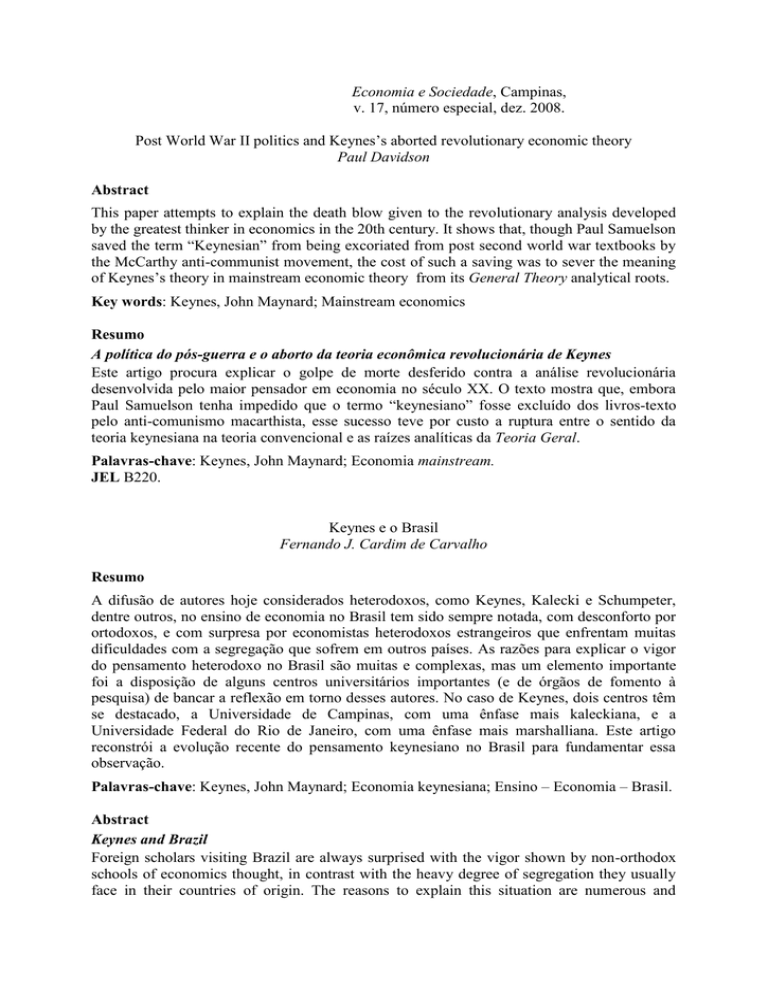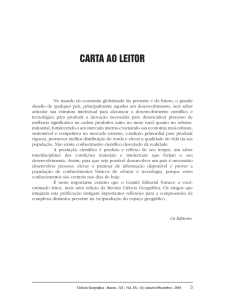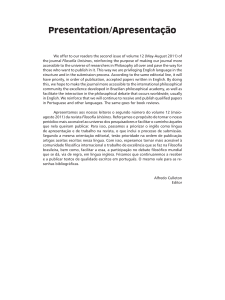
Economia e Sociedade, Campinas,
v. 17, número especial, dez. 2008.
Post World War II politics and Keynes’s aborted revolutionary economic theory
Paul Davidson
Abstract
This paper attempts to explain the death blow given to the revolutionary analysis developed
by the greatest thinker in economics in the 20th century. It shows that, though Paul Samuelson
saved the term “Keynesian” from being excoriated from post second world war textbooks by
the McCarthy anti-communist movement, the cost of such a saving was to sever the meaning
of Keynes’s theory in mainstream economic theory from its General Theory analytical roots.
Key words: Keynes, John Maynard; Mainstream economics
Resumo
A política do pós-guerra e o aborto da teoria econômica revolucionária de Keynes
Este artigo procura explicar o golpe de morte desferido contra a análise revolucionária
desenvolvida pelo maior pensador em economia no século XX. O texto mostra que, embora
Paul Samuelson tenha impedido que o termo “keynesiano” fosse excluído dos livros-texto
pelo anti-comunismo macarthista, esse sucesso teve por custo a ruptura entre o sentido da
teoria keynesiana na teoria convencional e as raízes analíticas da Teoria Geral.
Palavras-chave: Keynes, John Maynard; Economia mainstream.
JEL B220.
Keynes e o Brasil
Fernando J. Cardim de Carvalho
Resumo
A difusão de autores hoje considerados heterodoxos, como Keynes, Kalecki e Schumpeter,
dentre outros, no ensino de economia no Brasil tem sido sempre notada, com desconforto por
ortodoxos, e com surpresa por economistas heterodoxos estrangeiros que enfrentam muitas
dificuldades com a segregação que sofrem em outros países. As razões para explicar o vigor
do pensamento heterodoxo no Brasil são muitas e complexas, mas um elemento importante
foi a disposição de alguns centros universitários importantes (e de órgãos de fomento à
pesquisa) de bancar a reflexão em torno desses autores. No caso de Keynes, dois centros têm
se destacado, a Universidade de Campinas, com uma ênfase mais kaleckiana, e a
Universidade Federal do Rio de Janeiro, com uma ênfase mais marshalliana. Este artigo
reconstrói a evolução recente do pensamento keynesiano no Brasil para fundamentar essa
observação.
Palavras-chave: Keynes, John Maynard; Economia keynesiana; Ensino – Economia – Brasil.
Abstract
Keynes and Brazil
Foreign scholars visiting Brazil are always surprised with the vigor shown by non-orthodox
schools of economics thought, in contrast with the heavy degree of segregation they usually
face in their countries of origin. The reasons to explain this situation are numerous and
complex, but an important element is the willingness of some key academic institutions (and
some supporting financing institutions) to support research and teaching of authors such as
Keynes, Kalecki and Schumpeter, among others. Two in particular deserve mention, the
University of Campinas, developing a Kalecki approach to effective demand, and the Federal
University of Rio de Janeiro, exploring a more Marshallian avenue to Keynes. The paper
outlines the recent evolution of these two schools to demonstrate the preceding statement.
Key words: Keynes, John Maynard; Keynesian economics; Teaching of economics – Brazil.
JEL A20, E12.
O endividamento do consumidor no cerne do capitalismo conduzido pelas finanças
Robert Guttmann
Dominique Plihon
Resumo
Partindo de uma comparação entre a dinâmica de crescimento da União Européia e dos
Estados Unidos, este artigo tem por foco a dívida dos consumidores norte-americanos.
Embora a dívida dos consumidores tenha crescido em todo o mundo desenvolvido, em
nenhum lugar o processo foi tão longe como nos Estados Unidos. O artigo explora as razões
para isso. Uma análise das causas estruturais relaciona a explosão da dívida ao status
privilegiado do dólar norte-americano como moeda internacional e às inovações financeiras
decorrentes desse privilégio. Várias inovações associadas às hipotecas (securitização,
refinanciamento, home-equity withdrawals) converteram os norte-americanos em
“compradores em última instância”, permitindo a eles emitir mais e mais dívida contra o valor
de seus imóveis, ao mesmo tempo em que garantiam que esses ativos se apreciassem. O artigo
então examina por que tal padrão de crescimento não poderia prosseguir indefinidamente,
assim fornecendo uma nova explicação para a crise corrente, enraizada nos desequilíbrios
globais decorrentes de um sistema monetário internacional assimétrico.
Palavras-chave: Endividamento das famílias; Economia norte-americana; Financeirização.
Abstract
Consumer debt at the center of finance-led capitalism
Initially presented as a cross-regional comparison to highlight differences in the growth
dynamic of the European Union and the United States, this article focuses on U.S. consumer
debt. While households all over the developed world have come to use more debt, nowhere
has this process gone further and reached deeper than in the United States. The article
explores why this should have been so. A closer look at various structural causes traces the
recent explosion of U.S. household debt to the privileged status of the US-dollar as the
world’s vehicle currency and to the financial innovations flowing from this privilege. Various
innovations pertaining to mortgage loans (e.g. securitization, refinancing, home-equity
withdrawals) have turned Americans into the world’s “buyer of last resort” by letting them
borrow more and more against their rising home values while making also sure that those
assets appreciated in value. The article then examines why such a debt-financed growth
pattern could not go on indefinitely, thereby providing a new contextual explanation for the
ongoing crisis as rooted in global imbalances arising from an asymmetric international
monetary system.
Key words: Consumer debt; United States; Finance-led growth.
JEL E42, E43, E 44, E58, E63, F32, F33, F34, G01, G15, G18, G21, H63.
Las políticas monetaria y fiscal en un régimen de tipo de cambio competitivo
Roberto Frenkel
Resúmen
Este trabajo discute algunas características del régimen de tipo de cambio real competitivo
y estable (TCRCE). En el primer punto se presenta el régimen de TCRCE. A continuación
se plantea que el tipo de cambio real competitivo y estable puede inducir una presión
inflacionaria permanente, por los mismos mecanismos que estimulan altas tasas de
crecimiento del producto y el empleo. Esa presión debe ser compensada por un control
sobre la demanda agregada a través de las políticas fiscal y monetaria. En al segundo
punto se discute la autonomía monetaria en un régimen de TCRCE. La conclusión es que
se cuenta generalmente con un considerable grado de autonomía que puede ser utilizado
para ejercitar políticas monetarias activas. El tercer punto discute las posibilidades de la
política monetaria para servir de instrumento principal del control de la demanda
agregada. La conclusión es que la principal responsabilidad por el control de la demanda
agregada no puede cargarse sobre la política monetaria, de modo que el control debería
realizarse principalmente mediante la política fiscal.
Palabras-clave: Tasa de cambio real; Inflación; Crecimiento.
Abstract
Monetary and fiscal policies in a competitive real exchange rate regime
The paper discusses some characteristics of the Stable and Competitive Real Exchange
Rate regime (SCRER). A brief description of the regime is presented in the first section. It
is argued that a competitive real exchange rate might generate a permanent inflationary
pressure throughout the same mechanisms that stimulate high output and employment
rates of growth. This pressure should be contained by controlling aggregate demand with
fiscal and monetary policies. The second section discusses monetary autonomy in a
SCRER regime. It is concluded that a significant degree of monetary autonomy generally
exists that allows the implementation of active monetary policies. The third section
focuses on the possibilities of the monetary policy to perform as the main controlling
instrument of aggregate demand dynamics. It is concluded that monetary policy could not
perform the mentioned role and that the main responsibility for the control of aggregate
demand should be played by fiscal policy.
Key words: Real exchange rate; Inflation; Growth.
JEL F41, F31, E52.
New consensus macroeconomics and inflation targeting: Keynesian critique
Philip Arestis
Malcolm Sawyer
Abstract
A number of countries have adopted Inflation Targeting (IT) since the early 1990s in an
attempt to reduce inflation to low levels. Since then, IT has been praised by most literature as
a superior framework of monetary policy. We suggest that IT is a major policy prescription
closely associated with the New Consensus Macroeconomics (NCM). This paper concentrates
mainly on the IT aspects of the NCM. We address the theoretical foundations of IT. This is
followed by an assessment of its theoretical foundations, where a number of aspects are
discussed. We then turn our attention to an assessment of the empirical work on IT, where we
distinguish the work that has been done utilising structural macroeconomic models, and work
based in single equation techniques. The IT theoretical framework and the available empirical
evidence do not appear to support the views of the proponents.
Key words: New consensus macroeconomics; Inflation targeting; Interest rates.
Resumo
A macroeconomia do novo consenso e as metas de inflação: uma crítica keynesiana
No intuito de reduzir a inflação, vários países adotaram o regime de metas (RM) desde o
início da década de 1990. Deste então, o RM tem sido enaltecido pela maior parte da
bibliografia como um arranjo superior para a política monetária. Sugerimos que esse arranjo
está intimamente associado ao Novo Consenso Macroeconômico (NCM). Neste artigo,
discutimos e avaliamos os fundamentos teóricos do RM. Avaliamos também a pesquisa
empírica sobre ele, distinguindo os trabalhos que utilizam modelos macroeconômicos
estruturais e os que utilizam técnicas uniequacionais. A estrutura teórica do RM e a evidência
empírica disponível parecem não dar suporte às visões de seus proponentes.
Palavras-chave: Novo consenso macroeconômico; Inflação – Metas; Taxa de juros.
JEL E31, E52.
Economic growth, externalities and increasing returns to scale: what the data cannot show
Jesus Felipe
John McCombie
Abstract
The theoretical existence of the aggregate production function has been criticized in the
Cambridge Capital Theory Controversies and on the grounds of aggregation problems.
Attempts to answer these criticisms by recourse to econometric estimation and testing using
constant-price value data for output and capital encounter the problems posed by an
underlying accounting identity. We show by means of a simulation exercise that, because of
the identity, estimates of such parameters as the putative aggregate elasticity of substitution
may bear no relationship to the true values given by the hypothetical physical data at the firm
level. It is further shown using growth rates for UK manufacturing industries why the use of
value data in production function regressions will always give the result that there are
constant returns to scale and that the output elasticities are close to their respective factor
shares. In other words, the data cannot be used to test for the presence of increasing returns to
scale or externalities to capital accumulation.
Key words: Production function; Accounting identity; Returns to scale; Externalities.
Resumo
Crescimento econômico, externalidades e retornos crescentes de escala: o que os dados não
podem mostrar
A existência teórica da função de produção agregada foi criticada pela Controvérsia de
Cambridge e com base nos problemas de agregação. Tentativas de responder a essas críticas
por meio de estimações econométricas e usando valores a preços constantes para produto e
capital deparam-se com os problemas colocados por uma identidade contábil subjacente.
Mostramos, por meio de um exercício de simulação, que, devido a essa identidade,
estimativas de parâmetros como a suposta elasticidade de substituição podem não ter qualquer
relação com os verdadeiros valores, dados por dados físicos hipotéticos no plano da firma.
Ademais, usando as taxas de crescimento para a indústria de transformação britânica,
mostramos que o uso de dados de valor em regressões de função de produção sempre
mostrará retornos constantes de escala e elasticidades da produção próximas às participações
dos fatores. Em outras palavras, tais dados não podem ser usados para testar a presença de
retornos crescentes de escala ou externalidades à acumulação de capital.
Palavras-chave: Produção agregada; Identidade contábil; Externalidades.
JEL O47.
Una reconsideración de las perspectivas económicas de México
Julio López G.
Resúmen
Aunque la economía mexicana ha tenido un crecimiento lento desde hace casi tres décadas,
este artículo el autor argumenta qué hay razones para el optimismo si se aplica una estrategia
económica diferente de la que se ha venido siguiendo. Rescatando y ahondando en conceptos
desarrollados por economistas latinoamericanos estructuralistas, el autor sostiene que México
tiene abundantes recursos ociosos y que el énfasis de una estrategia de crecimiento
alternativa, debería ser poner a trabajar dichos recursos ociosos y, en particular, la fuerza de
trabajo desempleada y el equipo de capital sin utilizar. En este contexto, se proponen medidas
de corto y largo plazo capaces de asegurar un alto ritmo de crecimiento del producto y del
empleo, cuidando también los equilibrios de precios y externo.
Palabras-clave: Desarrollo económico; Economía mexicana.
Abstract
Mexico’s economic perspectives reconsidered
Although the Mexican economy has grown at a dismal rate for almost the last three decades,
in the present article the author argues that there are reasons to be optimistic if a different
economic strategy from the one presently ruling is implemented. Recovering and deepening
ideas and concepts developed by Latin American Structuralist authors, the author holds that
Mexico has plenty of idle resources and, in particular, plenty of unemployed labor force and
the unused capital equipment. In this context, short- and long-run measures are proposed,
capable of assuring a high rhythm of output growth and of employment, even as price and
external equilibria are safeguarded.
Key words: Economic development; Economic strategies; Mexican economy.
JEL E6, O2, O5.












